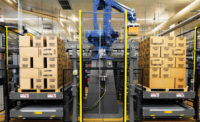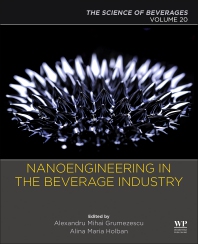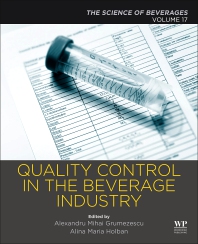Robotics in beverage operations continues to grow
Continued acceptance allows for market growth

FANUC’s CR-35iA collaborative robot is a 35-kg payload force limited collaborative robot designed to work alongside humans without the need for safety fences. (Image courtesy of FANUC America Corp.)

FANUC’s six-axis M-710iC/45M robot offers high-speed operation, a 2.6-meter reach and a 45-kg payload. The company notes that it’s ideal for high-throughput case palletizing and de-palletizing. (Image courtesy of FANUC America Corp.)


In Styx’s 1983 hit “Mr. Roboto,” the band sings, “Thank you very much, Mr. Roboto; For doing the jobs that nobody wants to.” Little did the band know, robots eventually would take on an immense amount of jobs that warehouse workers find repetitive and boring.
Although the sci-fi robots depicted in the music video are more similar to the Cybermen in a late 1960s episode of “Doctor Who” than the reality of robots, in 1983, the thought of widespread use of robots was far in the distance. Today, however, robots are setting records. Ann Arbor, Mich.-based the Robotics Industries Association (RIA) released a report in August stating that the North American robotics market had its fastest start ever in the first half of 2015.
According to the RIA, a record 14,232 robots valued at $840 million were ordered from North American robotics companies in the first half of the year, which is an increase of 1 percent in units, and 7 percent in units for the same period in 2014.
“We’re encouraged by the continued strength in the North American robotics market,” said Jeff Burnstein, president of the RIA, in a statement. “The interest in robotics remains strong not just in North America, but all over the world as companies recognize that robots can help them improve productivity, product quality and flexibility.”
Gaining share
It’s common knowledge that the automotive industry dominates the use of robotics; however, a possible explanation for this sudden growth within the last few years could be the increased interest from other industries.
An article published in September 2014 by Pricewaterhouse Coopers LLC (pwc), New York, titled “Robots are landing new jobs…in new industries” supports this. The article notes that new advancements in robot technology have led to new industries dipping their feet into robotics. And the numbers support this.
“In 2005, 69 percent of all industrial robot orders in North America were made by automotive original equipment manufacturers of automotive components companies, according to data from Robotic Industries Association,” the article states. “By 2014, that figure had eroded to 56 percent, offset by increasing shares by other industries including food and beverage, and consumer goods industries.”
The report also notes that the food and consumer goods industries accounted for a 7 percent share of North American robotic orders in 2014, opposed to their 3 percent market share in 2005.
Robotic solutions suppliers note this trend. “Robot integration in the beverage industry continues to grow,” says Wes Garrett, authorized system integrator sales for FANUC America Corp., Rochester Hills, Mich. “As companies introduce new beverage products and seasonal packaging, robotic automation provides the flexibility and efficiency to help reduce time to market, which is a major competitive advantage.”
Matt Jobs, business unit manager of automation for Hartness International, Greenville, S.C., adds that the biggest trend in robotics within the beverage industry is continued acceptance in the market. Jobs also notes that several years ago, larger companies were more commonly investing in robotic solutions, but today more and more smaller beverage companies are beginning to see the value.
“The price point isn’t as important, because they’re starting to see the value it brings,” he says. “What we’ve been able to do is get really standardized parts in the marketplace, which has helped bring down the cost of our products.”
Jobs notes that most customers are looking for an 18-24 month return-on-investment (ROI).
FANUC’s Raad Asmaro, authorized system integrator sales, notes that this range is reasonable. “Robotic system investment size can range dramatically depending on the size of robot and peripheral equipment required,” he says. “Most systems will achieve a two-year ROI or better in some cases.”
Getting integrated
Although more companies are integrating robots into their operations, suppliers note that those that haven’t often have concerns about integrating robots. However, they note that education and support are all that is necessary to diminish these concerns.
“The No. 1 concern we hear day-in and day-out has to do with familiarity with robotics, the perception that they’re black box and the perception that [the companies] don’t have the ability to support them,” Hartness’ Jobs says. “It’s the unknown if they don’t have robotic technology in-house.
“Technology from Hartness, to ensure that’s not a concern, operates as a standard or traditional machine,” he continues. “We’ve used existing technology to be the main bases of the machine, and the robot is a segment of it.” However, Jobs says that the No. 1 thing for a customer is training.
FANUC’s Asmaro adds that companies newer to robotics tend to be concerned with reliability and ease-of-use. “With a Mean Time Between Failure (MTBF) rate of 100,000-plus hours, FANUC’s proven reliability helps ease customer concerns,” he says. “In addition, our strong network of talented system integrators provides easy-to-use system interfaces that simplify operation.”
According to Asmaro, FANUC and its authorized system integrators offer warehousing solutions for palletizing and de-palletizing, automated storage and retrieval systems (ASRS), ecommerce order filling and general material handling.
Although robotics clearly offers many operations great advantages, suppliers note that a beverage company has several factors it should consider before integrating robotics into operations.
“Obviously, first would be application: is the application right? Is it a good fit for automation, not just for robotics?” Hartness’ Jobs says. “Second would be who the integration partner is. The beverage market is very different from a speed standpoint. Having an integration partner who understands the beverage market is essential.
“The third thing is typically material handling. Who has that material handling experience in that market?” Jobs continues. “Beverage has the niche things [these companies] do. …No. 4 is making sure that [the company] has the willingness to invest in new technology. The idea of robotics is that you’re gaining flexibility, but you have to have the willingness to invest. It’s not going to be a traditional machine, and they have to make sure to treat it that way — with eyes wide open.”
What’s coming?
Robotics have the potential to enter more streams of the beverage distribution, according to Bill Leber, business development manager for warehouse and distribution solutions for Swisslog, Newport News, Va. However, the integration is not without its challenges. “Automation has gotten a bad name among distributors, and that’s why we don’t see the environment for investment,” he explains. “I think the beverage industry will eventually get there, but right now, I haven’t seen it. The environment and willingness to make the investment for a 3-5 year payback is fertile.”
For now, robotics continues to grow within beverage manufacturing, and innovation is expected to continue. Hartness’ Jobs notes that ensuring overall operational effectiveness boils down to making machines run at their best, and he notes self-diagnostics as one place these robots could go.
“A lot of that’s in beverage, and that’s where that market is moving upwards — smarter interfaces that do their own diagnostics,” he says.
Asmaro notes that to keep up with beverage industry demands, robot performance needs to continuously improve, but even without these innovations it’s clear that robotics must continue to prove its benefits to beverage manufacturers of all sizes.
“If manufacturers are looking to reduce labor cost, improve production throughput and minimize floor space requirements, they should definitely consider robotic automation,” Asmaro says.
Looking for a reprint of this article?
From high-res PDFs to custom plaques, order your copy today!












